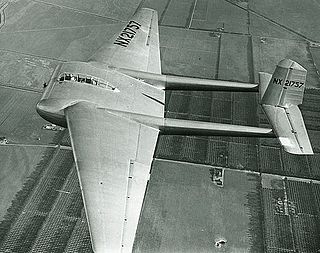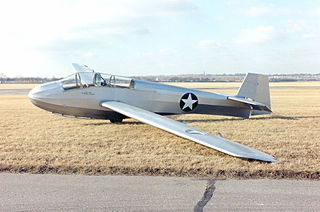Related Research Articles

The XCG-16 was a military transport/assault glider ordered by the United States Army Air Forces (USAAF), from General Airborne Transport Co., for competition against the Waco CG-13A at Wright Field. The XCG-16’s preferred tow aircraft was the Lockheed Model 18 Lodestar.

The Bell R-12 was an American 1940s military utility helicopter built by the Bell Helicopter company. The design did not go into full production, but over a dozen prototypes were used for various tests and projects.

The Schneider Grunau Baby was a single-seat sailplane first built in Germany in 1931, with some 6,000 examples constructed in some 20 countries. It was relatively easy to build from plans, it flew well, and the aircraft was strong enough to handle mild aerobatics and the occasional hard landing. When the Baby first appeared, it was accepted wisdom that the pilot should feel as much unimpeded airflow as possible, to better sense rising and falling currents of air and temperature changes etc.

The Schweizer SGS 2-8 is an American two-seat, mid-wing, strut-braced, training glider built by Schweizer Aircraft of Elmira, New York.

The Schweizer SGS 2-12 is a United States two-seat, low-wing, training glider built by Schweizer Aircraft of Elmira, New York.

The Laister-Kauffmann TG-4 was a sailplane produced in the United States during the Second World War for training cargo glider pilots. It was a conventional sailplane design with a fuselage of steel tube construction and wooden wings and tail, covered all over with fabric. The pilot and instructor sat in tandem under a long canopy.
The Briegleb BG-6 was a 1930s single-seat glider designed by William G. Briegleb to be both factory and homebuilt.
The St. Louis CG-5 was a 1940s American prototype military transport glider designed and built by the St. Louis Aircraft Corporation.
The SZD-25A Lis was a single-seat glider aircraft that was designed and built in Poland from 1955, derived from the SZD-16 Gil and SZD-25 Nov.

The Pratt-Read TG-32 was a 1940s American military training glider, designed and built by the Gould Aeronautical Division of the piano manufacturer Pratt, Read & Company of Deep River, Connecticut, for the United States Navy. The Pratt-Read glider was a monoplane glider having a fabric-covered steel tube fuselage and wooden wings and tail. The unique "polywog (tadpole)" shape was the suggestion of aerodynamicist Charles Townsend Ludington, former owner of the Ludington Line.

The Bowlus BS-100 Super Albatross is a single seat, mid-wing glider that was designed by Hawley Bowlus in 1938.

The Schreder Airmate HP-11 is an American mid-wing, V-tailed, single seat glider designed by Richard Schreder. Airmate was the name of Schreder's design company.

The Hütter Hü 17, is a German high-wing, strut-braced, single-seat, utility training glider that was designed by brothers Ulrich Hütter and Wolfgang Hütter in the 1930s.
The Reinhard Cumulus is a West German high-wing, strut-braced single-seat, glider that was designed by Gerhard Reinhard for amateur construction.
The Bowlus CG-8 was a prototype Second World War American transport glider to be built for United States Army, one was built but the type did not enter production and the programme was cancelled.
The Bowlus CG-7 was a prototype Second World War American transport glider to be built for United States Army, one was built but the type did not enter production and the programme was cancelled.
The Briegleb BG-08 was a 1940s two-seat glider designed by William G. Briegleb.
The Aero Industries TG-31 was a 1940s American military training glider, designed and built by students at the Aero Industries Technical Institute as the Aero Industries G-2 and impressed into military service as the Aero Industries TG-31 on 29 June 1942.
The Wichita Engineering TG-10 was a proposed American training glider conceived by Wichita Engineering in the early 1940s.
References
- 1 2 Heyman, Jos (February 1, 2015). "UNITED STATES MILITARY AIRCRAFT - Air Force - TG = Training Glider (1941-1947)" (PDF).